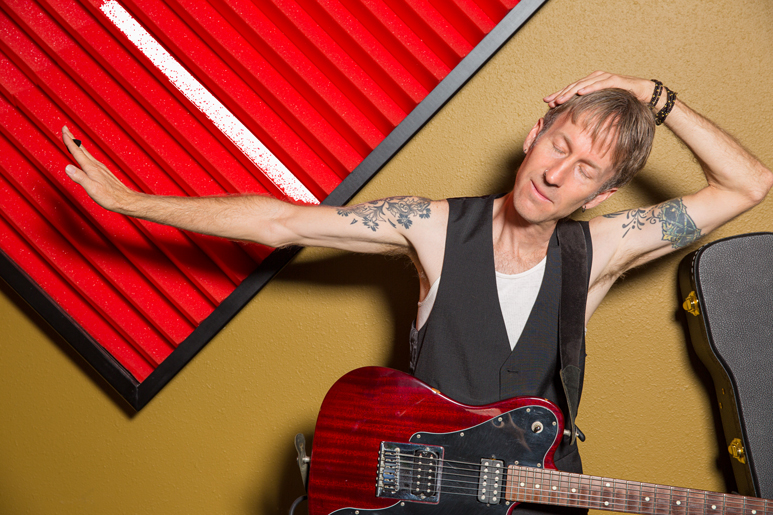Yoga health benefits are universal– pranayama and asana for musicians
Music is one of the purest forms of human communication. Musicians are the ambassadors and delivery boys and girls of the universal message of harmony, joy, and light…oh yeah, and the cathartic communion of the blues.
As conduits, musicians must transmit this godly information into the physical world through the training of their bodies and the use of tools of all shapes and sizes (like guitars, cellos, pianos, drums, etc.) that place the body in strange, uncomfortable positions for long periods of time while executing precise, repetitive motions. The musician may not notice any discomfort during performance due to its trance-like nature, but after the gig it’s a different story.
Many of the postures we assume while performing are imbalanced. The piano player hunches over the keyboard, the violinist locks the instrument between the chin and shoulder, the guitarist has a strap that rests the weight of the instrument solely on one side (my 1976 Fender Stratocaster weighs 10 pounds!).
I was on a tour of Europe in 2007 as the guitarist for a punk/goth band and I would do the first half of a modified Ashtanga primary series before each gig and the second half (mostly seated postures) after. I was pleased at how grounded this practice kept me in the chaotic world of a club tour. While others around me had moments of emotional turmoil and physical breakdown, I was able to keep a somewhat even disposition. Well, as even as you can be living on three hours of sleep a night. I believe yoga got me through, and this was what inspired me to write Yoga for Musicians. Sting, Madonna, and Peter Murphy can’t all be wrong.
Not to mention, as a yogi musician, I noticed that my periods of writer’s block were growing shorter and fewer. This is no small thing. My ability to be creative—even when I may not have felt like it—was fast, efficient, and the best part… not of me. I was/am a vehicle. My job was to get out of the way and keep my body clean and agile enough to be ready to perform and translate the information I was about to receive. Again, yoga was proving to have a lot to offer me as a musician.
Here are some specific asanas and pranayama we can do to keep our minds and bodies (vintage or not) in their purest working order so that we can be antennae to the universe and share the voices of the gods.
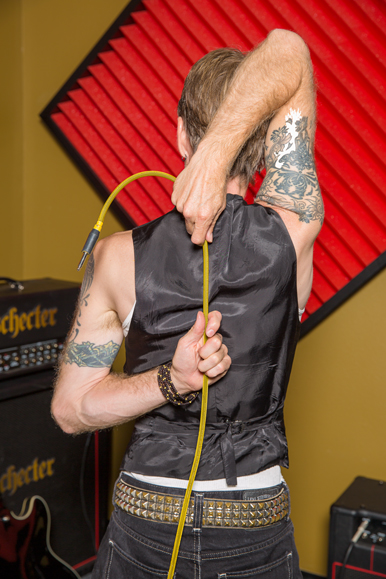 1. Rock and Roll Shoulders aka Gomukhasana
1. Rock and Roll Shoulders aka Gomukhasana
As musicians we want fluidity in our arms and shoulders. Let’s start at the shoulder, focusing on the top part of Gomukhasana.
You’ll be able to do this pose standing or sitting. I’ve seen a drummer do it in between songs sitting behind his kit.
Take a guitar strap, an instrument or microphone cable, or a drum stick in your right hand. Reach it into the sky and then down your spine. Then with your other hand, reach around your lower back and grab the other end of the object. You can now pull down a little with the left hand and at the same time creep the left hand closer to the right hand, making the gap between each hand smaller and smaller. Straighten the spine and sit or stand up tall. Push your head back into your raised arm so the tightness of your shoulder is not pushing the head forward, then pull your navel to your spine. Two steps beyond your comfort zone is the perfect place to stay. Breathe in through your nose deeply like you’re breathing to your feet. Then breathe out for the same duration. Maintain this position for five breaths, all through the nose, and then repeat on the left side.
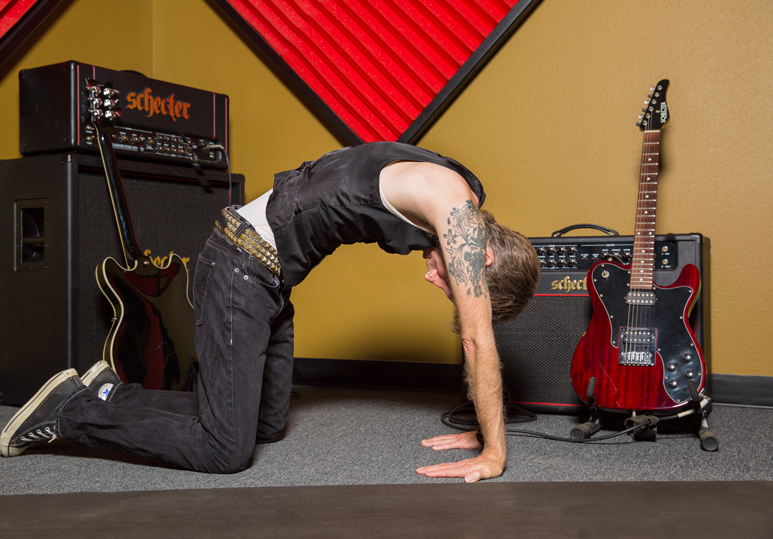
2. Heavy Metal Cat Wrists aka Marjariasana (hands reversed)
So many instruments take strong hands and forearms to play. Sometimes these areas get so strong they begin to lack the flexibility we also need.
We are going to modify cat pose to meet the needs of the musician’s wrists and forearms. This modification can seem extreme at first, so listen to your body and don’t be afraid to say, “I don’t think this works for me.” It’s your body; it’s your practice. We are trying to make things better, not worse.
Come to your hands and knees with your knees about two fists apart and your wrists directly under your shoulders. Arch your back like a cat on Halloween and look through your arms at your legs. Stay here for three breaths. The modification of this pose is to rotate the hands outward until the fingers are pointing back towards the knees. Arch the back again slowly, looking at your legs, and notice how your wrists and forearms react. Hold this for three long breaths and release. I’ve grown to love this version of Marjariasana. I hope you do too.
3. Blues Neck and Wrists
The neck can be one of the hardest areas to keep fluid. You may spend a couple hours nodding to the music—or even worse, banging your head—with a guitar strap resting on your trapezius. Or holding a trumpet or flute to your lips with your shoulders by your ears the whole time. If you look at pictures of Miles Davis over the years, you can see him transition from shoulders up to his ears leaning forward into the microphone to the photo that was used on his US stamp where he is moving the opposite direction in some kind of leaning back, Miles yoga.
You can do this asana standing or sitting with the spine straight. Let your right ear fall to your right shoulder. Reach your right arm up and rest it on the left side of your head. Do not pull or push; use only the weight of the arm to induce a further stretch. Stay for two breaths, then reach your left arm straight out from the shoulder and pull the fingers back like you’re pushing the wall out… or like you’re in a Supremes video saying, “Stop in the name of love.” Hold for four long breaths. Now do the other side.
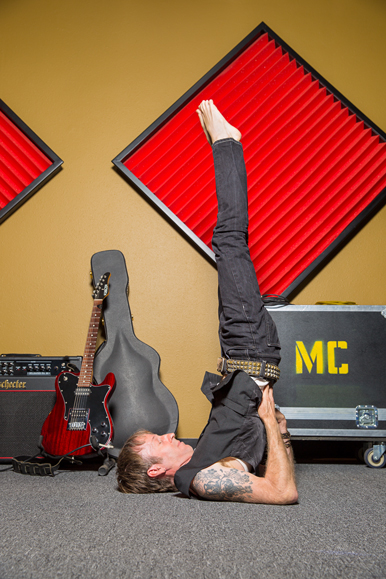 4. Shoulder Stand aka Sarvangasana
4. Shoulder Stand aka Sarvangasana
With the recently released photo of Mick Jagger doing Sarvangasana, it’s hard to deny its musical lineage. Sarvangasana is probably one of the most beneficial poses in yoga today. It is said that this asana enhances overall health, improves circulation and boosts sexual function. How can you go wrong? The new perspective we receive when we invert the body excites the creative process. Meanwhile, the weight of the pose opens the shoulders, and the gravitational pull on our internal organs is rejuvenating. As we lean into a microphone, hunch over the drum set and let the weight of our instruments pull us down, gravity becomes the enemy. And if gravity is the musician’s enemy, Sarvangasana is your secret weapon.
Sarvangasana will serve you best if you do it last. Do at least a couple of the other asanas first, then start with plow (halasana) as a transitional pose.
Lying on the ground, kick your feet up and over your head like you’re trying to put your hips over your shoulders. Place your hands on your back with your fingers pointing up. Keep the legs straight and allow your toes to fall towards the earth. For shoulder stand, simply lift your feet into the air and point your toes to the sky. Try to keep the weight of this pose in your shoulders and your elbows, but not so much in your head and neck. Bring the elbows together like you’re trying to make them the same distance as your shoulders. Try to lengthen into a straight line from your shoulders—which bear the majority of the weight—all the way to your toes. If making that line straight (shoulders to toes) puts pressure on your head and neck, try a little bend at the waist to release that. Stay here for 10 breaths.
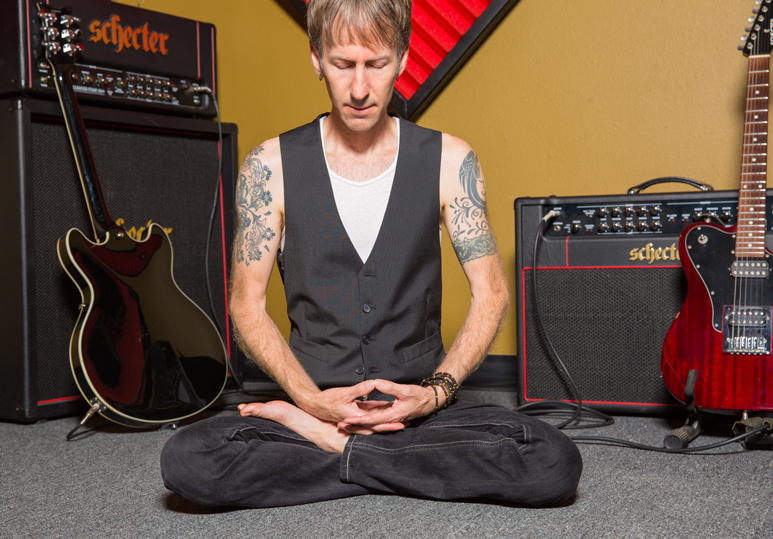
5. Meditation
The number of musician mediators probably outweighs the number of musician asana practitioners at least two to one: Flea, George Harrison, Billy Gibbons, Moby, Eddie Vedder and on and on. So I feel obligated to add this. Besides, it’s super beneficial to musicians… and to all humans, really.
Dhyana (meditation) is an important part of a well-rounded study of yoga. Dhyana as well as asana are parts of the eight-limbed path of The Yoga Sutras of Patanjali. This is the simplest meditation I have found that works for me:
Start by sitting comfortably, maintaining a straight back. Rest your hands in your lap with the palms facing up, right hand down, then left on top, thumbs touching (or fingers interlaced, palms facing up, thumbs together). Become aware of the breath rising and falling in the belly. Let thoughts come and go without focusing on them. If you get attached to a thought and go for a ride, come back to watching the breath, like a cat watching a mouse. Fifteen minutes a day is a great start.
With asana and meditation, our minds and bodies are open enough to allow the songs of the universe to download straight into our souls for later broadcast. This is why we are here on earth.
As vibration shamans raising the collective spirit of humanity, we should keep our backs straight, minds clear, and the decibel meters in the red. If the gods can’t hear it, turn it up to 11.
Daniel Overberger has been teaching yoga for over 10 years and did his teacher training in Mysore, India. He has also toured the world playing guitar, written, produced and recorded music for film and television and released two albums of yoga music with his band, Dharma Gypsys. www.leavingstressbehind.com
Photos by Jeff Skeirik
Special thanks to Schecter Guitars.
Daniel Overberger is a Los Angeles-based Yoga teacher, the author of Leaving Stress Behind, and founder of alt-kirtan group Dharma Gypsys. leavingstressbehind.com

